Spinning Yarn: "Narnia: The Lion, the Witch and the Wardrobe"
 |
"Once there were four children whose names were Peter, Susan, Edmund, and Lucy. This story is about something that happened to them ..."
-- C.S. Lewis
... and thus begins the Narnia opus, in the dulcet tones that accommodate the classic bedtime fables. The universal compulsion to tell a tale, the passing of knowledge from old to young, dates as far back as the act of storytelling itself. So, too, is the compulsion to jump on a bandwagon when it makes a bajillion dollars. Star Wars spawned dozens of outer-space imitators. Nirvana gave birth to a multitude of mumbly grunge bands. And The Lord of the Rings -- you get the picture.
So now the first of what could be many Narnia films is upon us. Gaze at the broad outlines of The Lion, the Witch and the Wardrobe and you'll find the plot and character pivots that graced the Rings cycle: innocent travelers in strange lands, the swell of heroism versus the darkest villainy, exotic creatures engaging in grand battles. But the quotation above exemplifies the subtle difference between C.S. Lewis and J.R.R. Tolkien -- while both fashioned escapist epics in the shadow of real-life world wars, the latter wanted nothing less than to create a mythology from wholecloth, a society buttressed by chivalric notions and painstakingly-created dialects, while the former simply wanted to tell a few good yarns.
 As we all know by now, the Narnia series is more than a yarn, it is Christian allegory with a capital C. But it succeeds because it assuages children's fantasies and insecurities -- it celebrates the simultaneous terror and excitement of being lost in a foreign universe, as well as the comforting knowledge that home, hearth, and normalcy is a twist of a ring or a blunder through a crowded wardrobe away. In Lewis's world, a cozy cup of tea with a fawn holds as much thrill as doing battle with wicked witches. If one should learn a few understated lessons about Christian charity along the way, so much the better -- it's certainly no worse than other Disney pap that glorifies less sundry precepts (Uncle Remus, anyone?).
As we all know by now, the Narnia series is more than a yarn, it is Christian allegory with a capital C. But it succeeds because it assuages children's fantasies and insecurities -- it celebrates the simultaneous terror and excitement of being lost in a foreign universe, as well as the comforting knowledge that home, hearth, and normalcy is a twist of a ring or a blunder through a crowded wardrobe away. In Lewis's world, a cozy cup of tea with a fawn holds as much thrill as doing battle with wicked witches. If one should learn a few understated lessons about Christian charity along the way, so much the better -- it's certainly no worse than other Disney pap that glorifies less sundry precepts (Uncle Remus, anyone?).Directed by Andrew Adamson (Shrek), The Lion, the Witch and the Wardrobe has a heavy brief to fulfill; not only must it satisfy the followers of the Lewis books, but it must also slake the thirst of filmgoers who have become accustomed to a certain brand of fantasy -- that is, Peter Jackson's mammoth take on Tolkien. The resulting product is rife with these tensions. On the one hand, it attempts to capture much of the spirit of the original, down to its modest tale-by-the-fire vibe. On the other, there is plenty of digital legerdemain in evidence, and much of the noisy action (scored with sturm-und-drang strings and chorales, of course) that typified Rings. Oh, and the New Zealand filming locations, too.
 The movie is a close retelling of the book, and Lewis shines through most clearly in the film's first and second acts, wherein young Lucy (Georgie Hensley) and Edmund (Skandar Keynes) find their way through that magical wardrobe into Narnia. Adamson relies only on a smattering of special effects in these passages; more important are the looks of wonder on his child actors' faces, how the snowy woods are as real as any snowy woods one might find anywhere. In an age where every mystical land is represented in motion pictures by heavily-doctored CGI, this is a brave choice, and one that pays off for the most part. While we catch the sparkle of amazement and fun in Lucy's eyes, we also watch approvingly as Edmund, the needy and neglected younger brother, finds his soul mate in the White Witch (Tilda Swinton), who baits him with promises of Turkish delight and princely power. Here we have the classic conundrums of a children's story: the pull of dreams and imagined places, the temptations and decisions. Swinton invests her villain with brittle sensitivity -- she may be a wrong one, but she's a wrong one attuned to others' needs and weaknesses -- and her confrontations with Edmund provide the film with its dramatic bite. Adamson directs all this with a light, almost breezy touch, and it's a perfect antidote to all the teeth-gritting misery that permeates most modern epics.
The movie is a close retelling of the book, and Lewis shines through most clearly in the film's first and second acts, wherein young Lucy (Georgie Hensley) and Edmund (Skandar Keynes) find their way through that magical wardrobe into Narnia. Adamson relies only on a smattering of special effects in these passages; more important are the looks of wonder on his child actors' faces, how the snowy woods are as real as any snowy woods one might find anywhere. In an age where every mystical land is represented in motion pictures by heavily-doctored CGI, this is a brave choice, and one that pays off for the most part. While we catch the sparkle of amazement and fun in Lucy's eyes, we also watch approvingly as Edmund, the needy and neglected younger brother, finds his soul mate in the White Witch (Tilda Swinton), who baits him with promises of Turkish delight and princely power. Here we have the classic conundrums of a children's story: the pull of dreams and imagined places, the temptations and decisions. Swinton invests her villain with brittle sensitivity -- she may be a wrong one, but she's a wrong one attuned to others' needs and weaknesses -- and her confrontations with Edmund provide the film with its dramatic bite. Adamson directs all this with a light, almost breezy touch, and it's a perfect antidote to all the teeth-gritting misery that permeates most modern epics. As soon as older siblings Susan (Anna Popplewell) and Peter (William Moseley) step into Narnia, however, the narrative's dramatic focus dissipates -- a flaw also present in the novel. Peter and Susan are functional but uninteresting protagonists, which just goes to show that "fallen" characters like Edmund have more pull than virtuous leading gentlemen and ladies. As the plot grows swollen with chases, encounters with mystical creatures (including Jesus -- um, I mean, Aslan the heroic CGI lion (played by Liam Neeson, who really needs a break from these "older mentor" roles)), and a flash of a final battle between light and dark that is over almost as soon as it begins, the effects also switch into overdrive. They wobble between seamless (the talking wolves who hunt the children), charmingly corny (the beaver couple who aid our heroes, voiced by Ray Winstone and Dawn French), and plain unconvincing (many of the locales and lesser beasts). More problematic is the glossing over of much of the book's lore, the intricacies of deep magic and deep magic from before the dawn of time. Lacking the grace notes of fancies like these to hold onto, we're left with another grim countdown to another clash of the armies. The filmmakers may be suffering from Ring fatigue, as we all are -- after the exhausting battles and exhaustive locales we were exposed to in Jackson's cycle, could Adamson have hoped to compete? He gives it a game try, but without the maniac intensity that Jackson invested in his climaxes, he doesn't stand a chance.
As soon as older siblings Susan (Anna Popplewell) and Peter (William Moseley) step into Narnia, however, the narrative's dramatic focus dissipates -- a flaw also present in the novel. Peter and Susan are functional but uninteresting protagonists, which just goes to show that "fallen" characters like Edmund have more pull than virtuous leading gentlemen and ladies. As the plot grows swollen with chases, encounters with mystical creatures (including Jesus -- um, I mean, Aslan the heroic CGI lion (played by Liam Neeson, who really needs a break from these "older mentor" roles)), and a flash of a final battle between light and dark that is over almost as soon as it begins, the effects also switch into overdrive. They wobble between seamless (the talking wolves who hunt the children), charmingly corny (the beaver couple who aid our heroes, voiced by Ray Winstone and Dawn French), and plain unconvincing (many of the locales and lesser beasts). More problematic is the glossing over of much of the book's lore, the intricacies of deep magic and deep magic from before the dawn of time. Lacking the grace notes of fancies like these to hold onto, we're left with another grim countdown to another clash of the armies. The filmmakers may be suffering from Ring fatigue, as we all are -- after the exhausting battles and exhaustive locales we were exposed to in Jackson's cycle, could Adamson have hoped to compete? He gives it a game try, but without the maniac intensity that Jackson invested in his climaxes, he doesn't stand a chance. Fortunately, the conclusion of this particular tale is bliss on a modest scale. After spending their adolescence in Narnia, the four children (now mature princes and princesses of the realm) wander into the woods, and stumble out of the wardrobe, reduced to their original young selves. It's a narrative fillip that has been stolen by many other stories (even Star Trek: The Next Generation), but it still retains its power, especially when the stunned children receive a final gentle warning by fey professor Kirke (an underused Jim Broadbent). Strange that the image of four bewildered children falling out of a wardrobe and getting lectured by a grown-up holds more sway than a multitude of talking animals doing battle, but such is the pull of a good yarn, and C.S. Lewis knew it -- if this film is the progenitor of a new fantasy franchise, Disney would do well to note the same.
Fortunately, the conclusion of this particular tale is bliss on a modest scale. After spending their adolescence in Narnia, the four children (now mature princes and princesses of the realm) wander into the woods, and stumble out of the wardrobe, reduced to their original young selves. It's a narrative fillip that has been stolen by many other stories (even Star Trek: The Next Generation), but it still retains its power, especially when the stunned children receive a final gentle warning by fey professor Kirke (an underused Jim Broadbent). Strange that the image of four bewildered children falling out of a wardrobe and getting lectured by a grown-up holds more sway than a multitude of talking animals doing battle, but such is the pull of a good yarn, and C.S. Lewis knew it -- if this film is the progenitor of a new fantasy franchise, Disney would do well to note the same.

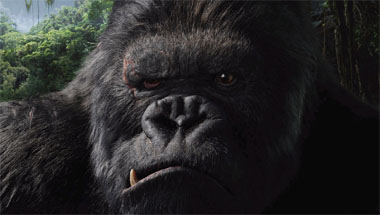
 Peter Jackson avoids these roads -- just barely -- in his newest tale, titled, ahem,
Peter Jackson avoids these roads -- just barely -- in his newest tale, titled, ahem, 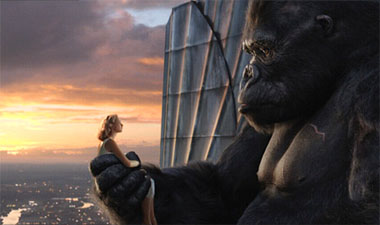
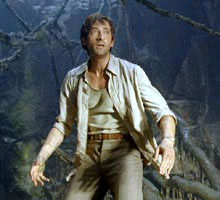 But Jackson is no xerox machine, cranking out carbons of the past. As a filmmaker, he has established his own unique take on the world as a charnel house where the dessicated and the creepy-crawly are mere inches away, where old-fashioned emotion and melodrama are stretched into hyper-operatic realms, where every moment of repose is overwhelmed by assaults of digitally-created horrors and equally queasy camera zig-zags. The central section of Kong, set amongst the unrelenting dangers of Skull Island, is the embodiment of this style, and no surprise, it's the best part of the movie. Jackson may steal from Spielberg's Jurassic Park and Indiana Jones pictures, but his pulverizing, no-rest-for-the-weary approach is all his own. Kong doesn't get to battle just one dino, but three at once, trading blows and plummeting down chasms in a ceaseless flurry of movement. Heroic Jack Driscoll (Adrien Brody) doesn't fight off a single giant spider, he combats a whole hoard of them. Every moment of suspense or grandiose special effect is lingered over, wrung like a wet towel. This would be deadly if your typical hack was at the helm, but Jackson has learned a thing or two from his Lord of the Rings cycle about pace and movement. For such a heavy-handed director, his work is fleet and free of smugness. He may be pleased with his creations, but he never assumes the audience is, and with showman instincts, he keeps his three-ring circus moving along, dashing from one setpiece to the next. It's popcorn, but like other great mainstream entertainers, Jackson knows how to supply the pop.
But Jackson is no xerox machine, cranking out carbons of the past. As a filmmaker, he has established his own unique take on the world as a charnel house where the dessicated and the creepy-crawly are mere inches away, where old-fashioned emotion and melodrama are stretched into hyper-operatic realms, where every moment of repose is overwhelmed by assaults of digitally-created horrors and equally queasy camera zig-zags. The central section of Kong, set amongst the unrelenting dangers of Skull Island, is the embodiment of this style, and no surprise, it's the best part of the movie. Jackson may steal from Spielberg's Jurassic Park and Indiana Jones pictures, but his pulverizing, no-rest-for-the-weary approach is all his own. Kong doesn't get to battle just one dino, but three at once, trading blows and plummeting down chasms in a ceaseless flurry of movement. Heroic Jack Driscoll (Adrien Brody) doesn't fight off a single giant spider, he combats a whole hoard of them. Every moment of suspense or grandiose special effect is lingered over, wrung like a wet towel. This would be deadly if your typical hack was at the helm, but Jackson has learned a thing or two from his Lord of the Rings cycle about pace and movement. For such a heavy-handed director, his work is fleet and free of smugness. He may be pleased with his creations, but he never assumes the audience is, and with showman instincts, he keeps his three-ring circus moving along, dashing from one setpiece to the next. It's popcorn, but like other great mainstream entertainers, Jackson knows how to supply the pop.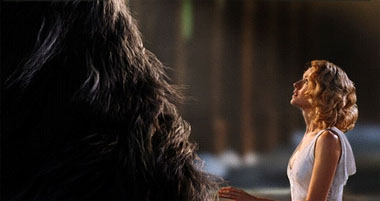
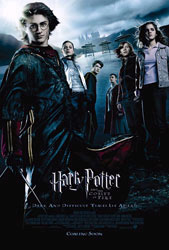
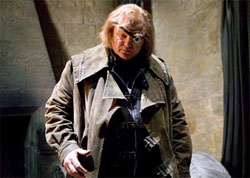 Even now, four movies into the saga, it strikes me how much those basic parameters remain unchanged. Harry (Daniel Radcliffe) is as likeably milquetoast as ever, his pal Ron Weasley (Rupert Grint) still does a mean double take at every strangeness thrown his way, and Hermione (Emma Watson) still lectures and stamps her foot impatiently at how
Even now, four movies into the saga, it strikes me how much those basic parameters remain unchanged. Harry (Daniel Radcliffe) is as likeably milquetoast as ever, his pal Ron Weasley (Rupert Grint) still does a mean double take at every strangeness thrown his way, and Hermione (Emma Watson) still lectures and stamps her foot impatiently at how 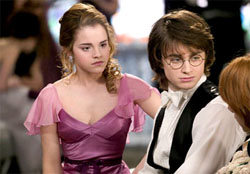 And yet, the contrast between this film and the first are remarkable. If nothing else, it's fascinating to see what entropy has wrought on our cast of principals -- once-reedy Radcliffe has filled and flattened out, while Grint, the original shrimp of the bunch, is now positively lanky (it helps that he's cultivated the comic timing to make the most of his gangliness). Most intriguing is Watson, who seems to have entered the "quirky-beautiful" territory once inhabited by Anna Paquin. At times her scrunched-up face looks almost homely, and at other times it's radiant. Fittingly enough, she seems closer to being an actual adult than the other two, and a fetching one at that.
And yet, the contrast between this film and the first are remarkable. If nothing else, it's fascinating to see what entropy has wrought on our cast of principals -- once-reedy Radcliffe has filled and flattened out, while Grint, the original shrimp of the bunch, is now positively lanky (it helps that he's cultivated the comic timing to make the most of his gangliness). Most intriguing is Watson, who seems to have entered the "quirky-beautiful" territory once inhabited by Anna Paquin. At times her scrunched-up face looks almost homely, and at other times it's radiant. Fittingly enough, she seems closer to being an actual adult than the other two, and a fetching one at that.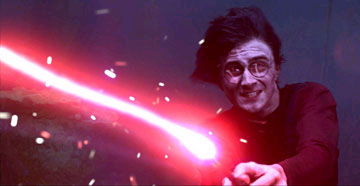
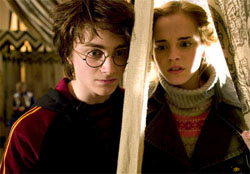 I'll leave it to the Potter-ites to obsess over the minutae -- such as whether Dumbledore's final eulogy packs the same tenor that it does in the book, or if Katie Leung is a suitable Cho Chang, who I'm told will become Harry's main squeeze. (An aside: is it just me, or does it seem somewhat condescending that many critics are noting how "endearing" it is that a girl of Asian descent has a Scots accent? By that reckoning, I suppose we should be similarly smitten by Asian chicks who speak Valley Girl.) Aye, but there's the rub. There's those darn monolithic books to stay true to. Newell does a yeoman's job of moving the proceedings along, but there's still a touch of stodginess to it all -- you can almost hear the pages turning. The first fifteen minutes in particular, in which Harry and friends are mysteriously attacked at a Quidditch tournament, are shot in disinterested fashion, as if Newell can't be bothered to do much beyond regurgitating the book's events. The most successful films based on novels introduce pleasures that you can't necessarily glean from the written page. Peter Jackson's
I'll leave it to the Potter-ites to obsess over the minutae -- such as whether Dumbledore's final eulogy packs the same tenor that it does in the book, or if Katie Leung is a suitable Cho Chang, who I'm told will become Harry's main squeeze. (An aside: is it just me, or does it seem somewhat condescending that many critics are noting how "endearing" it is that a girl of Asian descent has a Scots accent? By that reckoning, I suppose we should be similarly smitten by Asian chicks who speak Valley Girl.) Aye, but there's the rub. There's those darn monolithic books to stay true to. Newell does a yeoman's job of moving the proceedings along, but there's still a touch of stodginess to it all -- you can almost hear the pages turning. The first fifteen minutes in particular, in which Harry and friends are mysteriously attacked at a Quidditch tournament, are shot in disinterested fashion, as if Newell can't be bothered to do much beyond regurgitating the book's events. The most successful films based on novels introduce pleasures that you can't necessarily glean from the written page. Peter Jackson's 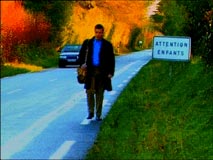 In Praise of Love (Eloge de L'Amour) (2001, Dir. Jean-Luc Godard)
In Praise of Love (Eloge de L'Amour) (2001, Dir. Jean-Luc Godard)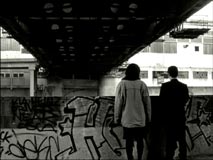 And then I happen upon something like In Praise of Love. It's not a great film; I'm not even sure it's a good film. But it has stuck with me. I saw it for the first time three years ago, at the San Francisco International Film Festival, with a captive (in both senses of the word) audience. Tonight, I saw it for the first time since then. But that's not accurate -- tonight is the first time I've seen it from beginning to end since then. In the interim, I've seen it plenty, but only scattered moments, glimpses of scenes, bits of dialogue and visuals and music. Two moments in particular -- more on this in a bit.
And then I happen upon something like In Praise of Love. It's not a great film; I'm not even sure it's a good film. But it has stuck with me. I saw it for the first time three years ago, at the San Francisco International Film Festival, with a captive (in both senses of the word) audience. Tonight, I saw it for the first time since then. But that's not accurate -- tonight is the first time I've seen it from beginning to end since then. In the interim, I've seen it plenty, but only scattered moments, glimpses of scenes, bits of dialogue and visuals and music. Two moments in particular -- more on this in a bit.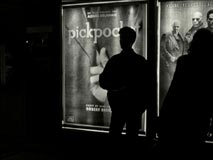 Strangely enough, it's isolated moments, the ones freed from what sliver of story there is or Godard's despairing worldview, the ones that are specific fusions of images and sounds (or if you like, pure cinema), that stay with me. This was a startling realization for me, because I am usually all about the story, the plot, the movement. Without story, what is there? And yet, here I am rapt with the stasis of it all, how the camera is content to sit and observe and record striking juxtapositions of people and places. The cinematography is gorgeous; that alone is inspirational. The first hour of the film is shot on black-and-white film in a wintry Paris, littered with casual shots of boulevards at night, homeless folks asleep on benches or cuddling with each other in sleeping bags, crystalline rooms where Edgar auditions actors. One can't miss the point when our protagonist stands before a movie house, a poster of Bresson's Pickpocket and a poster for The Matrix butting heads, but it works, because the image is haunting in its matter-of-factness.
Strangely enough, it's isolated moments, the ones freed from what sliver of story there is or Godard's despairing worldview, the ones that are specific fusions of images and sounds (or if you like, pure cinema), that stay with me. This was a startling realization for me, because I am usually all about the story, the plot, the movement. Without story, what is there? And yet, here I am rapt with the stasis of it all, how the camera is content to sit and observe and record striking juxtapositions of people and places. The cinematography is gorgeous; that alone is inspirational. The first hour of the film is shot on black-and-white film in a wintry Paris, littered with casual shots of boulevards at night, homeless folks asleep on benches or cuddling with each other in sleeping bags, crystalline rooms where Edgar auditions actors. One can't miss the point when our protagonist stands before a movie house, a poster of Bresson's Pickpocket and a poster for The Matrix butting heads, but it works, because the image is haunting in its matter-of-factness.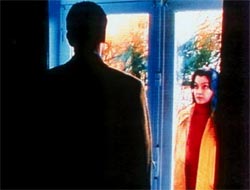 The second half of the film, which takes place in Brittany, is presented in overwhelming color -- ironic, since it's supposed to take place two years before the first half. To be more specific, it's shot in oversaturated digital video, and to this day I still think it's the most remarkable use of the medium I've seen in a major film. The images leap, but they also have weight, character. An actual story emerges (Spielberg's lawyers buying the rights to a French Resistance couple's story, and threatening to sugarcoat it as a Juliette Binoche prestige flick), but even this is tangential to the isolated moments. Like the one where Edgar and Elle meet for the first time -- an exquisitely framed shot. Or the increasingly frequent images of waves crashing against the shores, or those collages in which the characters seem to be swamped by those very waves, as history and meaning crash, converge, and drown. Which brings me to my two favorite moments of the film.
The second half of the film, which takes place in Brittany, is presented in overwhelming color -- ironic, since it's supposed to take place two years before the first half. To be more specific, it's shot in oversaturated digital video, and to this day I still think it's the most remarkable use of the medium I've seen in a major film. The images leap, but they also have weight, character. An actual story emerges (Spielberg's lawyers buying the rights to a French Resistance couple's story, and threatening to sugarcoat it as a Juliette Binoche prestige flick), but even this is tangential to the isolated moments. Like the one where Edgar and Elle meet for the first time -- an exquisitely framed shot. Or the increasingly frequent images of waves crashing against the shores, or those collages in which the characters seem to be swamped by those very waves, as history and meaning crash, converge, and drown. Which brings me to my two favorite moments of the film.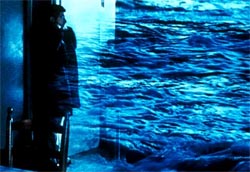 If you happen to rent or buy this film, skip forward to 1:25:50 (it's the section appropriately named "Red Orchestra" (L'Orchestre Rouge) in the intertitles). At this point, the characters have been talking about impermanence, acceptance, even religion. But all this talk does not compare to what follows: a long, wordless, sustained shot of waves lapping against the shore at night, the town's lights like slivers as they run across them, the water moving back and forth, the soundtrack reverberating with the melancholy warmth of multitracked cellos (a few days ago I finally tracked down the artist and the title of the piece: David Darling,"Song for TKJD," from the album
If you happen to rent or buy this film, skip forward to 1:25:50 (it's the section appropriately named "Red Orchestra" (L'Orchestre Rouge) in the intertitles). At this point, the characters have been talking about impermanence, acceptance, even religion. But all this talk does not compare to what follows: a long, wordless, sustained shot of waves lapping against the shore at night, the town's lights like slivers as they run across them, the water moving back and forth, the soundtrack reverberating with the melancholy warmth of multitracked cellos (a few days ago I finally tracked down the artist and the title of the piece: David Darling,"Song for TKJD," from the album 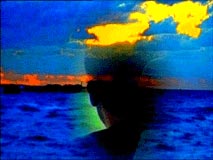 About eight minutes later, the second remarkable passage: Elle is driving Edgar to the airport, at night, in the rain. We know from earlier in the film that Edgar's project will never be completed, that Elle will commit suicide two years later, that this may be the last restful moment the two of them share. None of this is telegraphed or milked. Instead we see the view out the front windshield, cars passing in the night like figments of thought, rain spattering on the windows, David Darling's piece coloring it all once again, but this time with a more ethereal effect. For me, it recalls every dark night on every rainy road I have ever experienced, and the unexpected muted joys at such moments. The airless discussions that clog In Praise of Love don't have a chance against overpowering cinema such as this, but I come not to bury the film and how its polemics fall short, or even engage it on the level that it demands to be engaged (Jean-Luc may not be too pleased about that). Instead, I come to praise these bursts of light and shadow, the particular mix of electrons, this art seemingly conjured from thin air -- how elements merge unexpectedly to create fragments of time that stir, and suggest, and communicate. For would-be artists like me, there's nothing more invigorating.
About eight minutes later, the second remarkable passage: Elle is driving Edgar to the airport, at night, in the rain. We know from earlier in the film that Edgar's project will never be completed, that Elle will commit suicide two years later, that this may be the last restful moment the two of them share. None of this is telegraphed or milked. Instead we see the view out the front windshield, cars passing in the night like figments of thought, rain spattering on the windows, David Darling's piece coloring it all once again, but this time with a more ethereal effect. For me, it recalls every dark night on every rainy road I have ever experienced, and the unexpected muted joys at such moments. The airless discussions that clog In Praise of Love don't have a chance against overpowering cinema such as this, but I come not to bury the film and how its polemics fall short, or even engage it on the level that it demands to be engaged (Jean-Luc may not be too pleased about that). Instead, I come to praise these bursts of light and shadow, the particular mix of electrons, this art seemingly conjured from thin air -- how elements merge unexpectedly to create fragments of time that stir, and suggest, and communicate. For would-be artists like me, there's nothing more invigorating.
